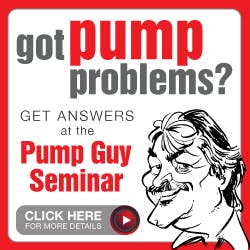I am a project engineer for a Midwest municipality wastewater authority. I’d like your opinion on some recent events with a pump.
In 2010, we installed a new variable-speed pump at the final collecting station at the treatment plant. The pump operates between 500 RPM and 600 RPM. The speed varies to maintain a constant water level in the wet well 7 feet over the pump centerline.
Since 2010, we have documented the following issue: The pump starts and runs up to 600 RPM (25,000 GPM) when the high level sensor trips in the wet well. The pump speed slowly reduces, sometimes to 500 RPM (20,850 GPM) as the level drops in the well. If incoming flow increases into the well, the pump speed reaccelerates.
However, after the pump speed reaccelerates to 600 RPM, the flow peaks at about 22,000 GPM rather than 25,000 GPM. Sometimes the level in the well continues to rise even with the pump at 600 RPM. The only way to return to 25,000 GPM and control the level in the well is to stop and restart the pump. As we stop the pump, we lose the discharge water column back into the well and this further exaggerates the problem and the anxiety.
We called the pump manufacturer. The engineer referred to a “time dependent steady state capacity drift” issue. After the engineer repeated the term a couple of times, he reduced it to “TDSSCD.” I have never heard of this term.
We will remove the pump from service and inspect it for signs of air entrainment or a suction recirculation problem. Is there any sign or indicator that might identify or support suction recirculation?
Also, what do you know about TDSSCD?
Regards,
Harry R.
Hello Harry,
Three points come to mind that might affect the flow through your pump.
- Consider air/gas entrainment: Remember you’re pumping intestinal waste (methane gas) and air from every commode flush that feeds the lift station. Air and gas can collect at the impeller eye and block flow into the pump, which will reduce the discharge flow.
- Consider air vortices: Vessels tend to form vortices (air tornadoes) when filled and drained at the same time. The vortex is attracted to the tank exit nozzle and the pump. The air can fill the pump and displace the liquid leading to reduced flow.
- Consider the foot valve: In your message, you said you lose your liquid column back into the well when the pump is turned off. If the flapper is stuck and won’t actuate properly, it can either starve the pump or cause excess turbulence that releases air and gas into the pump.
An impeller suffering suction recirculation normally shows damage on the leading edge (the high pressure side) of each impeller blade close to the eye of the impeller. You will see this on examining the impeller blades when the pump is disassembled.
An impeller suffering air or gas entrainment normally shows damage on the trailing edge (the low pressure side) of each blade close to the eye of the impeller. We cover these issues with plenty of pictures in my Pump Guy Seminar series. (For more information on upcoming Pump Guy trainings in Chicago and Philadelphia and a full course outline, visit FlowControlNetwork.com/PumpGuy.)
Some Thoughts on Acronyms in General
In the 1980s, our society became aware of an illness that was called the “Auto-Immune Deficiency Syndrome.” This long phrase began consuming a lot of time and energy in spoken conversation and medical conferences. The term consumed a lot of paper and ink in newspapers and press releases, eventually being reduced to the acronym AIDS.
Many years ago, the French marine explorer Jacques Cousteau perfected a device that allowed humans to stay under water for long periods. Cousteau called his device the “Self-Contained Underwater Breathing Apparatus.” After repeating this phrase many times in conversation and print, self-contained underwater breathing apparatus became the acronym scuba.
In the Second World War, there was a small military utility vehicle that any soldier could start and drive without a key if one were available. The vehicle was labeled “Government Property.” Eventually the Government Property became known as a G.P. This is the vehicle we know today as the Jeep.
TV will always be short for television. And PC will always be short for personal computer. But scuba is in a family of acronyms like Jeep, laser, radar, aids and sonar that have become their own words. Many people don’t even know they are acronyms.
Personally, I don’t think TDSSCD exists. I believe the phrase “Time Dependency” exists in many communications. I believe the term “Steady State” is a rather popular term in some circles. And “Drift” is a term used by instrumentation technicians. But TDSSCD doesn’t, in my opinion, exist. This seems like someone’s attempt to appear IIL (Inside the Info Loop).
LOL,
Larry Bachus
Larry Bachus, founder of pump services firm Bachus Company Inc., is a regular contributor to Flow Control magazine. He is a pump consultant, lecturer, and inventor based in Nashville, Tenn. Mr. Bachus is a retired member of ASME and lectures in both English and Spanish. He can be reached at [email protected].




